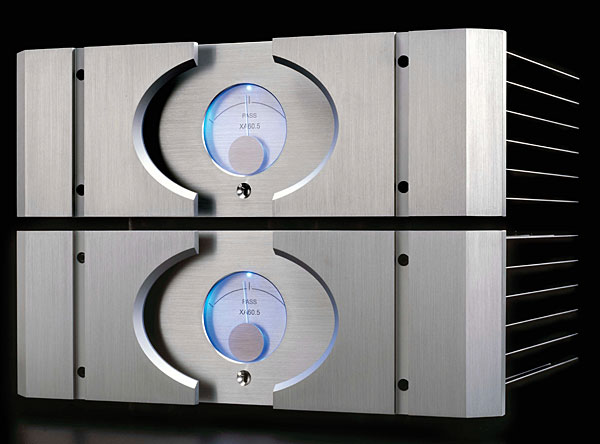| Columns Retired Columns & Blogs |
And what about The Brinkmann Bardo that you also reviewed?
Maybe you should do a follow up with the 12" tonearm and the EMT Ti element?
Pass Labs XA60.5 monoblock power amplifier ($11,000/pair; reviewed by John Atkinson, January 2014, Vol.37 No.1 Review)
In a list of finalists that was more or less evenly divided between preamps and power amps, and more or less evenly divided between tubes and transistors, one product stood above all others: the XA60.5 solid-state mono amplifier from Pass Labs, which enchanted John Atkinson on all but the warmest days of summer. (The amp runs moderately but not dangerously warm.) This recent design from the legendary Nelson Pass, a man who approaches his craft with equal measures of engineering chops and unbridled imagination, is the second-least-expensive model in the XA line, and uses Pass's patented and gloriously noisephobic Supersymmetry topology. While noting its slight departure from the ideal in terms of bass control, John Atkinson described the Pass XA60.5 as "the best-sounding amplifier I have ever used." Notwithstanding the five-figure price for a pair of these monoblocks, the Pass is considerably less expensive than most other contenders for the best. "Class A all the way!" says the august JA.

Notes on the vote: It's interesting that two of the 10 finalists in the Amplification Component of the Year category—the Pass XA60.5 (no.1) and the Constellation Centaur (no.10)—can sort of be described as single-ended, balanced, class-A amplifiers. How's that for symmetry?
Finalists: (in alphabetical order)
Audio Research SP20 preamplifier ($9000; reviewed by Robert J. Reina, June 2014, Vol.37 No.6 Review)
Constellation Performance Centaur monoblock amplifier ($54,000/pair; reviewed by Michael Fremer, November 2013, Vol.36 No.11 Review)
Dan D'Agostino Master Audio Systems Momentum preamplifier ($32,000; reviewed by Michael Fremer, August 2014, Vol.37 No.8 Review)
Lamm Industries LL1 Signature preamplifier ($42,790; reviewed by Robert J. Reina, August 2014, Vol.37 No.8 Review)
MBL Corona C15 monoblock power amplifier ($25,000/pair; reviewed by John Atkinson, June 2014, Vol.37 No.6 Review)
Naim NAIT 5si integrated amplifier ($1895; reviewed by Herb Reichert, October 2014, Vol.37 No.10 Review)
Rogue Audio Sphinx integrated amplifier ($1295; reviewed by Herb Reichert, August 2014, Vol.37 No.8 Review)
Simaudio Moon Evolution 850P preamplifier ($30,000; reviewed by Brian Damkroger, December 2013, Vol.36 No.12 Review)
VTL Siegfried Series II Reference monoblock amplifier ($65,000/pair; reviewed by Michael Fremer, May 2014, Vol.37 No.5 Review)

And what about The Brinkmann Bardo that you also reviewed?
Maybe you should do a follow up with the 12" tonearm and the EMT Ti element?

What about the 2014 Editor's Choice? Has John Atkinson actually heard this speaker? I know that he hasn't measured it. I understand that the editor's choice category has been expanded to give every Stereophile contributor the opportunity to nominate an audio component that particularly impressed, but that seems to defeat the purpose of having an editor's choice. I hasten to add that I have heard the SCM19 and regard it highly. However, it is not an efficient stand-mounted speaker and requires a powerful amplifier for optimum performance - a drawback of the sealed enclosure design presumably (Ben Lilly of ATC recommended an amplifier rated at 150W plus). That notable caveat is missing from the "Editors' Choice" blurb.

What about the 2014 Editor's Choice? Has John Atkinson actually heard this speaker? I know that he hasn't measured it.
No, I haven't heard this ATC.
I understand that the editor's choice category has been expanded to give every Stereophile contributor the opportunity to nominate an audio component that particularly impressed, but that seems to defeat the purpose of having an editor's choice.
I thought it appropriate to expand the category, to give each the reviewer the opportunity to nominate their personal favorite of the past year. I don't think that was unclear.
John Atkinson
Editor, Stereophile

I find it odd how a component that has not been auditioned by the editor of Stereophile can qualify as an editor's (or editors') choice.
I didn't find the explanation for expanding the category unclear, but I think that the title has become misleading as a consequence. Changing the title to reviewers or contributors favourites would more accurately reflect just who is making the choices don't you think?

I find it odd how a component that has not been auditioned by the editor of Stereophile can qualify as an editor's (or editors') choice.
It is usual in publishing in the US to refer to regular contributors to a magazine as "editors," with the person who edits the magazine (me in the case of Stereophile) called the "editor-in-chief." Hence each product listed in this year's "Editor's Choice" is indeed the choice of an editor.
If you wish, you can think of this feature as being called "Editors' Choices." But I am okay with the existing title.
John Atkinson
Editor (In Chief), Stereophile

That's interesting. An editor and a contributor are distinctly different roles in publishing - hence the titles. I'm familiar with the structure of an editor-in-chief, editorial staff and writing staff.
So you are saying that at Stereophile there is effectively no practical distinction between an editor and a contributor and this is common practice in US publishing. Then why make the distinction at all and why formalise it by naming a category after it?
Given that Stereophile's Editors' Choices of 2014 are actually those of the contributors, I think a change of title to reflect this actuality would be appropriate and more meaningful.